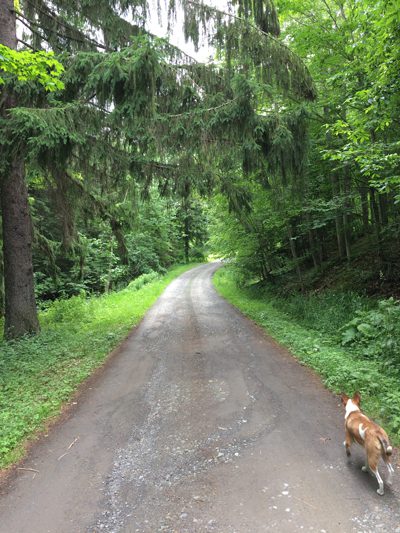I’ve been writing for Mountain Laurel Recovery Center for a couple of months now, using knowledge based on their website, my correspondence with staff members, and their Facebook page.
Last week, my husband and I, along with our dog Diggity, drove two and a half hours to utmost northern PA so my husband could fix their tech issues, Diggity could have an adventure, and I could finally see the facility and meet the staff in person. None of us were disappointed (except my husband, when the tech proved trickier than he’d expected).
Tioga County, in the wilds of PA, is beautiful. We drove on empty winding roads surrounded by green mountains in a countryside broken only by the occasional farmhouse, gas station, or roadside market.

Where the pipe organ used to be.
The “boonies,” Executive Director George Rutherford wrote in an email, and glorious boonies it was. MLRC itself is only about 10 miles from the Pennsylvania Grand Canyon, and Trinity Cowburn, the Clinical Director, takes groups of residents to her favorite overlook there to enjoy the healing power of nature.
The facility is in the small town of Westfield and set far back from the road with acres of grass and woods stretching behind it, bliss for a small dog who loves to run.
We park and walk to the main building, the historic Eberle mansion now renovated into offices, cafeteria, and a large living room with a working grand piano (“there’s always someone playing the piano, even if they don’t know what they’re doing,” someone said). A large, mirrored wall ornament turns out to have replaced what used to be a pipe organ.

Chopsticks, anyone?
Some of the residents are working on a project in the yard when we arrive. Others are gathered in a gazebo, chatting while they wait for their next activity. Everyone seems thrilled to see Diggity. MLRC had a resident dog for several years, adopted from a local shelter, but last year he became so attached to a particular resident that he went home with him.

Trinity’s garden
We meet Trinity, who takes us on a campus tour. (“She’s not 8 feet tall,” I later tell my husband. “She’s about my height.” He shrugs, “She was wearing heels when I met her.”) Trinity greets everyone we see by name and speaks with particular pride of the large garden in the yard: a pet project of hers she uses to relax and to teach gardening to interested residents. “One of our residents has sort of taken it over; I hardly have any work to do there now—she loves it,” she tells us. On the way to the fitness building, Trinity explains the large tractor tires next to the basketball court. Apparently, George is into cross-fit; he and the residents use the tires when they set up elaborate obstacle courses for their workouts. The fitness room looks like a typical gym: walls of mirrors and a wide range of free weights and machines.
In another large building, Trinity shows us a rec room with a ping pong table, pool table, large TV, desks, and a big circle of comfortable couches and chairs. She shows us the clean, comfortable detox rooms; we’re impressed that each room has its own TV. Everyone we see along the tour—residents, nurses, staff—greet us with friendly smiles, and almost everyone wants to pet Diggity (who, for the record, is being a very good boy).
When my husband leaves us to begin figuring out the tech issues, Trinity and I talk for awhile in her office (stay tuned for my next post, featuring our conversation); she apologizes for the clutter of boxes on the floor. She’s been gathering supplies for the alumni reunion weekend (which took place on Saturday, June 24); about 200 alumni responded to the invitation, an impressive number that attests to how much MLRC alumni valued their time here and continue to value the larger MLRC community.

Campus walk with Diggity
My husband and I join the staff for lunch, a salad bar in the cafeteria. As a salad bar aficionado (snob?), I’m pleasantly surprised with the options: spring mix, carrots, radishes, cucumbers, tomatoes, chic peas, sunflower seeds, cranberries, walnuts, chicken, shrimp, eggs, and more. The conversations range from dogs to video games to Beyonce to Buddhism. If you can judge a rehab by the happiness of its staff, I would say that MLRC is a thriving community.
The residents, who we see throughout the day as they travel between activities (group therapy sessions, a lecture on diet and fitness, private counseling sessions, group meetings, etc.), also seem happy. They joke with the staff and each other. It’s easy to forget that they are here to rebuild their lives as they recover from the deadly illness of substance use disorder.
Everyone is sad to see Diggity go. In fact, I’ve overheard Trinity plotting with some of the residents about how to keep him there when we leave. On the ride home I reflect on how excited I am to write from a more personal knowledge of Mountain Laurel and from an even stronger belief in the good work they do there. Keep reading the blog for interviews with MLRC staff and alumni and more detail on the ways MLRC helps clients build their physical, emotional, and spiritual health.
